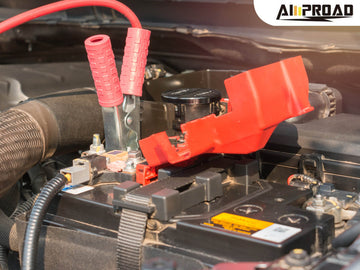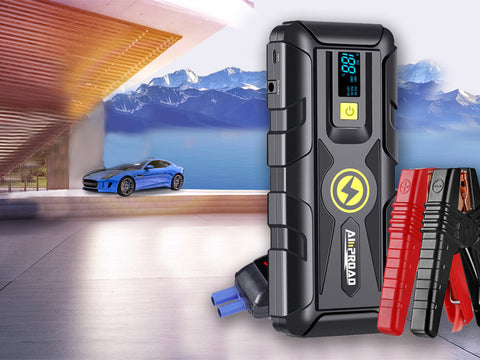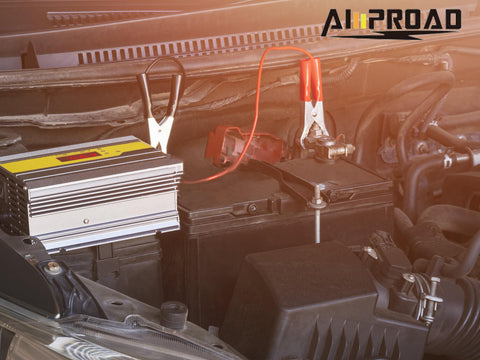
Dead car batteries can transform from roadside emergencies into manageable situations with the right equipment at hand. Essential tools like jumper cables or portable jump boxes provide swift solutions, allowing the vehicle's alternator to restore power once the engine turns over. While this process typically leads to a successful recharge, severely depleted batteries may require replacement at a nearby auto parts retailer. Safety remains paramount during jump-starting procedures, as batteries can emit flammable gases. Following proper cable connection sequences helps minimize spark risks and ensures a secure restart.
Jump Start Your Car with Jumper Cables
Ensuring a safe jump-start involves preventing the metal ends of jumper cables from touching each other or any metal surfaces under the hood. Navigating the metal-rich engine compartment makes this tricky, but with two people, one can hold the cable ends apart while the other connects them to the batteries. Jump-starting alone is possible but demands careful attention. Consult your car's manual for the correct connection order, as variations may exist among car makes. Universally, the accepted method involves connecting the red jumper cable clamp to the positive (+) terminal of the dead battery, then the other red clamp to the positive terminal of the booster car's battery. Next, connect the black clamp to the negative (-) terminal of the booster car's battery, and finally, ground the other black clamp to an unpainted metal surface on the dead car's engine block. This method minimizes the risk of sparks, ensuring a safer jump start process. Always prioritize safety to prevent accidents or damage during this procedure.

Jump Start Your Car with A Jump Box or Portable Jump Starter
A dead car battery is a frustrating experience, often leaving you stranded at the most inconvenient times. Thankfully, when car won’t start, jump boxes and portable jump starters provide a convenient solution, allowing you to revive your vehicle without relying on the assistance of another car. Here, we'll explore how to boost a car using these portable devices, making the process hassle-free and accessible for everyone.
- Select A Good Jump Box or Jump Starter
Jump boxes and portable jump starters, both provided by reputable suppliers like Amproad, share the common goal of offering self-contained solutions for jump-starting vehicles. Despite their shared objective, these tools differ in design and functionality.
Both jump boxes and portable jump starter from trusted manufacturers like Amproad are characterized by their compact, portable nature. They house their own power sources, typically rechargeable batteries, ensuring they can independently provide the necessary boost to start a vehicle. Safety features, such as overcharge protection and reverse polarity protection, are often integrated, prioritizing user safety during the jump-starting process.
The primary distinction lies in their physical design. Jump box, often supplied by quality manufacturers like Amproad, typically feature a more robust and durable exterior, resembling a small toolbox. These units often come with additional functionalities like built-in air compressors or power outlets, enhancing their versatility for various roadside needs. On the other hand, portable jump starter, also from reputable suppliers like Amproad, are generally more streamlined and compact, prioritizing ease of storage and transport without compromising on quality.
While jump boxes excel in added durability and versatility, portable jump starters stand out for their lightweight and highly portable designs. The choice between them ultimately depends on individual preferences and the specific needs of the driver. Regardless of the selection, opting for tools from trusted suppliers like Amproad ensures a reliable solution for addressing dead car batteries, providing independence from other vehicles, and enhancing the overall safety and convenience of jump-starting processes.
- Identify Battery Terminals
Start by opening the hood. Once the hood is open, your next task is to locate the positive (+) and negative (-) terminals of the car battery. These terminals are crucial for the jump-starting process. The positive terminal is usually marked with a plus sign (+), and the negative terminal is marked with a minus sign (-). Take a moment to familiarize yourself with their locations. Ensure you're working in a well-lit environment and that there are no flammable materials nearby. Identifying these terminals is the foundational step in successfully jump-starting your vehicle. Once you've located them, you'll be ready to connect the battery jump starter and breathe life back into your car. Always prioritize safety and follow recommended procedures during this process.

- Connect the Clamps
After identifying the positive (+) and negative (-) terminals of your car battery, the next step in jump-starting is connecting the clamps. Take the red clamp from your car jump starter and securely attach it to the positive terminal of the car battery, marked with a plus sign (+). Ensure a snug fit for a strong connection. Subsequently, connect the black clamp to a clean, unpainted metal surface within the engine bay. This serves as a grounding point, minimizing the risk of sparking during the jump-starting process. Importantly, avoid attaching the black clamp to the negative terminal to prevent potential safety hazards. These careful connections lay the foundation for a safe and effective jump-start, bringing your car back to life. Always follow recommended procedures and prioritize safety throughout the entire process.
- Power On
Once the clamps are securely connected, the next step in jump-starting your vehicle is to power on the battery jumper start or jump box. Locate the power button or switch on your device and turn it on. This activates the jump starter, allowing it to channel the necessary charge into your car's battery. Ensure the device is receiving power and is ready for use before attempting to start your car. This straightforward action sets the stage for a successful jump-start.
- Start Your Car
With the battery jump starter or jump box powered on and the clamps securely connected, it's time to initiate the engine start. Slide into the driver's seat and turn the key or push the ignition button, depending on your vehicle's design. Attempt to start your car. If the engine doesn't roar to life immediately, resist the urge to persistently crank the ignition. Instead, wait for a minute or two before trying again. This brief interval allows the car jump box near me to transfer an ample charge to your car's battery, increasing the likelihood of a successful start. Patience is key during this step, and it ensures a more effective and safe jump-starting process. If your car still doesn't start after a few attempts, it might be wise to assess the connections, recharge the jump starter, or seek professional assistance.
- Disconnect the Clamps
Successfully starting your car marks a significant step in the jump-starting process. Now, it's time to disconnect the clamps. Start by removing the black clamp, which is connected to the clean metal surface in the engine bay. This step minimizes the risk of sparking near the battery. After removing the black clamp, proceed to disconnect the red clamp from the positive terminal of the car battery. Always exercise caution during this process, ensuring the clamps do not come into contact with each other or any metal surfaces.
These steps, performed in the correct order, maintain safety and prevent potential electrical hazards. The careful disconnection of clamps ensures a smooth conclusion to the jump-starting procedure. Once the clamps are detached, you've successfully completed the process, and your car is ready to roll. Remember to handle the clamps with care, and if you faced difficulties starting your car, consider recharging the portable car jump starter promptly for future use. This comprehensive approach guarantees a secure and effective jump-start, allowing you to overcome the challenge of a dead battery with confidence.
- Charge the Jump Starter
Completing a successful jump-start is a relief, but the process doesn't end there. After your car engine is humming once again, it's crucial to turn your attention to the jump starter. Recharge it promptly to ensure it's ready for future use and can come to your rescue when needed.
A discharged jump starter won't be of much help in the next unforeseen circumstance, so this step is vital for maintaining its effectiveness. Most jump starters come with rechargeable batteries, and recharging them promptly is an easy yet crucial task.

Locate the charging port on your jump starter and connect it to a power source, following the manufacturer's instructions. It might take a few hours to reach a full charge, depending on the model and the level of depletion. While the temptation may be to stow the jumper pack back in your vehicle immediately, resist it. Ensuring it's fully charged guarantees maximum performance and reliability when you confront the next unexpected battery challenge.
Regularly checking and maintaining the charge of your car battery booster is a good practice. Some models even come with indicators that display the battery level, offering a quick glance at the readiness of your device.
Incorporate jumper starter charging into your routine after each use, making it as essential as refueling or checking tire pressure. This habit ensures you're always prepared for unforeseen circumstances, whether it's your own vehicle or assisting a fellow driver in need.
By prioritizing the charging of your battery booster, you transform it from a one-time solution into a reliable and consistent tool in your automotive toolkit. This simple yet crucial step ensures that your jump starter is not just a temporary fix but a dependable ally for countless journeys ahead.
Ensuring Your Jump Starter's Effectiveness: Tips for Use and Maintenance
Proper use and maintenance of your jump box or portable jump starter are key to ensuring its reliability in critical moments. Regularly charging your jump starter, especially if it has been idle for an extended period, is fundamental. This practice keeps the battery at optimal levels, ready to deliver a swift jump-start when needed. Following the manufacturer's instructions is equally crucial. Features may vary between jump starter models, and understanding the specific guidelines for your device enhances its effectiveness and longevity.
Storing your best portable jump starter in a cool, dry place is a simple yet impactful measure. Extreme temperatures can impact the performance of the device, so safeguarding it in a moderate environment contributes to its durability. Seeking professional help is advised if your vehicle consistently faces battery issues. Consulting a mechanic can identify and address underlying problems, preventing future battery-related challenges.
The Advantages of Jump Boxes or Portable Jump Starters
Jump boxes and portable jump starters offer a range of advantages, making them indispensable tools for drivers facing unexpected battery troubles. Their standalone nature provides independence from other vehicles, making them ideal for solo drivers navigating remote locations. The compact, lightweight design of these devices adds an element of convenience, offering an easy-to-use solution in emergency situations.
Safety features incorporated into modern jump starters, such as reverse polarity protection, mitigate the risk of damage resulting from incorrect connections. This not only safeguards your vehicle but also ensures the longevity of your starter jumper. Additionally, the versatility of portable jump starters goes beyond their primary function. Many models include extra features like USB ports, transforming them into multifunctional tools capable of charging other devices. Embracing the advantages of jump boxes or portable jump starters elevates them from emergency tools to essential components of your automotive preparedness toolkit.


